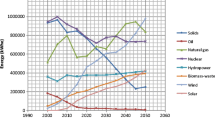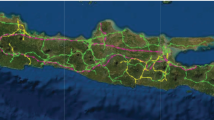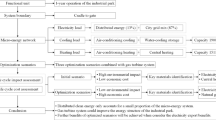Abstract
Goal, Scope and Background
The goal of this paper is to present the modeling of life cycle inventory (LCI) for electric energy production and delivery in Brazil for the reference year 2000 by application of ISO 14040. Site specific data along with sector production data have been combined to construct an energy production model, which has been applied to emissions estimation. Background-data of all the inputs and outputs from the system have been inventoried as follows: gross electric energy generation, installed nameplate capacity, flooded area, losses, emissions to air / water, process waste, used fuel, efficiency and land use.
Main Features
In Brazil, electricity is supplied to the various regions by an interconnected system composed of 418 electric companies, consisting of 389 hydraulic power plants and 29 thermal power stations. Due to this enormous number of companies, life cycle inventory for the electricity grid mix was developed on the basis of the following hierarchy: information received from companies (15), data from Brazilian Industrial Information System for the energy Sector (SIESE) and Brazilian Ministries. The functional unit was 1,000 MJ (278 kWh) of electricity distributed to electricity users. The main emissions from power stations, as well as those from fuel production, were investigated. The hydraulic process was not considered emission-free — a model was proposed where emissions of renewable CO2 and CH4 (hydro) are attributed to the degradation of plants submerged in the reservoir areas.
Result
The production and distribution of 1,000 MJ of electricity by the interconnected system in Brazil requires approx. 1,600 MJ of process energy, 230 kg of water (evaporated at thermal plants), 116 m3 of waterflow through the turbines, 13 kg of coal, 5 kg of biotic reserves and 0.25 m2a of land use. Emissions related to the 1,000 MJ electricity distributed were 18 kg of non-renewable CO2,17 kg of renewable CO2, 540 g of CH4, 575 g of NOx, 116 g of SO2,149 g of CO, among others. Thermal power stations are the main contributors to these emissions, except for CH4 and renewable CO2 being contributions from coal production and hydraulic power plants, respectively.
Conclusions
In spite of considering the emissions of CO2 and CH4 by the submerged plants in the flooded area of dams in hydropower stations, it has been shown that electric energy production is a very clean process due to the characteristics of the electric energy production in Brazil — 93.5% hydraulic. This means 1,000 MJ of delivered electricity produces approx. 34 kg of CO2, being 18 kg (53%) of non-renewable CO2 emitted by fossil fuel burning at thermal power plants that participate with only 6.5% of the electric energy production in Brazil. This was the first tentative model to express electric energy generation and distribution in Brazil in terms of LCA. In future, a more detailed study should be made in order to improve this model.
Outlook
A complementary paper will be produced in which future scenarios of the Brazilian electricity grid mix will be discussed, including possible alternatives to minimize the environmental impacts of hydropower plants.
Similar content being viewed by others
References
BEN (2002): Balanço Energetico Nacional 2001. Brasília: MME (Ministério das Minas e Energia — on-line) [cited on 04/08/2002]. Available at http://www. mme.gov.br
Bousted (1993): Eco-profiles of the European plastics industry — Report 2: Olefin feedstock sources. Brussels: APME, 24 p
Ventura V, Rambelli A (1996): Resolução CONAMA n° 008/90, de 06 de dezembro de 1990. Estabelece, em nível nacional, limites máximos de emissão de poluentes no ar para processos de combustão externa em fontes novas fixas de poluição. In: Legislação Federal sobre o meio ambiente. 2a ed. São Paulo: Vana, p 875-876
CHESF (2002): Companhia Hidro Elétrica do São Francisco. Available at http://www.chesf.gov.br (cited on 10.03.2002)
Coltro L, Garcia E, Gatti J, Jaime S, Madi L, Mourad A, Ortiz S (2000a): Life Cycle Assessment of Packaging — Electric Energy Modeling for Brazilian Situation, Advances in Packaging Development and Research. Jorges A. Marcondes (Ed.). Proceedings from the 20th International Association of Packaging Research Institute (IAPRI) Symposium, 14–18 June 2000, San Jose State University, San Jose, California, p 532
Coltro L, Jaime S, Garcia E, Gatti J, Gutierrez J, Mourad A, Ortiz S, Madi L (2000b): Application of Life Cycle Inventory Analysis to Energy Production in Brazil. In: R′2000 — World Congress on Integrated Resources Management, 5th, 2000, Toronto. Proceedings. Toronto: PEAK Ltd./Ministry of the Environment, CDROM, p 589-595
CSPE (2001): Usinas Termelétricas de Pequeno Porte no Estado de Sao Paulo, Comissão de Serviços Públicos de Energia do Estado de Sao Paulo, 400 pp
Dubreuil A (2001): Inventory for Energy Production in Canada. Int J LCA 6 (5) 281–284
EPA (1998): U.S. Greenhouse gas emissions and sinks: 1990-1996. EPA — Environmental Protection Agency, Washington
ILASA (1991): International database for ecoprofile analysis (IDEA). International Institute for Applied Systems Analysis. Laxenburg, Austria
IPCC (1996): Revised 1996 IPCC Guidelines for National Greenhouse Gas Inventories: Workbook. Paris: IPCC- Intergovernmental Panel on Climate Change, Vol 2, 190 pp
ISO14040 (1997): Environmental management — Life cycle assessment — Principles and framework — ISO 14040 -International Organization for Standardization, ISO, Geneva, 12 pp
Madi LFC, Garcia EEC, Coltro L, Mourad AL, Gatti JAB, Jaime SBM, Ortiz SA (1999): Análise de Ciclo de Vida de Embalagens para o Mercado Brasileiro. CETEA/ITAL, Campinas (confidential report)
Matsuno Y, Betz M (2000): Development of Life Cycle Inventories for Electricity Grid Mixes in Japan. Int J LCA 5 (5) 295–305
MCT (2001): Avaliação das emissões de gases de efeito estufa gerados na indústria de extração do carvão mineral — 1990/1994. Brasília: MCT/PNUD/ONU/SNIEC—Ministério de Ciência e Tecnologia. Available at http://www.mct.gov.br (cited on 7.16.2001), 182 pp
MCT/COPPE (2001): Emissões de Gases do Efeito Estufa derivados de Reservatórios Hidrelétricos. MCT, Instituto Alberto Luiz Coimbra de Pós-Graduação e Pesquisa de Engenharia (COPPE/UFRJ — Universidade Federal do Rio de Janeiro) e COPPETEC, Rosa LP (coord.). Available at http://www.mct.gov.br
Oliva R (2002): Energias renováveis para o desenvolvimento sustentável. In: ABRENER 2002: Encontro de energia no meio rural, 4. Anais. NIPE/UNICAMP, Campinas
PETROBRáS (1998): Relatório anual de Atividades 1997. Available at http://www.petrobras.com.br (cited on 3.24.1998)
PETROBRáS (1999): Relatório anual de Atividades 1998. Available at http://www.petrobras.com.br (cited on 7.13.1999)
Rosa L, Tolmasquim M, Pires J (1998): A reforma do setor elétrico no Brasìl e no mundo — uma visão crítica Relume Dumará. Rio de Janeiro, 211 pp
Schreiber G (1980): Usinas hidrelétricas. Edgard Blucher, São Paulo, 232 pp
SETAC (1993): Guidelines for Life Cycle Assessment: A Code of Pratice (1st Ed.), Society for Environmental Toxicology and Chemistry, Consoli F et al. (Eds), Brussels, Belgium and Pensacola, Florida, USA
SIESE (2001): Boletim Semestral do SIESE — Sistema de Informações Empresariais do Setor de Energia Elétrica. Síntese, Rio de Janeiro, 43 pp
SIPOT (2001): Sistema de Informação do Potencial Hidroelétrico Brasileiro. Divisāo de Recursos Hídricos e Inventários -DENI- Eletrobrás (Centrais Elétricas Brasileiras SA) /Ministério das Minas e Energia (MME)
SFEO (1994): Environmental life-cycle inventories of energy systems. ETH — Swiss Federal Energy Office, Zurich
Author information
Authors and Affiliations
Corresponding author
Rights and permissions
About this article
Cite this article
Coltro, L., Garcia, E.E.C. & Queiroz, G.d.C. Life cycle inventory for electric energy system in Brazil. Int J LCA 8, 290–296 (2003). https://doi.org/10.1007/BF02978921
Received:
Accepted:
Issue Date:
DOI: https://doi.org/10.1007/BF02978921




